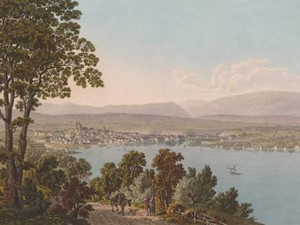
A settlement developed on the right bank of the Rhone as early as the Neolithic period. In Roman and early medieval times, people then lived on the left bank, where the view shows St-Pierre Cathedral on the highest point of the Cité hill.
Through the work of John Calvin from 1540, Geneva developed into a center of the Reformation and was also called "the reformed Rome". Although the city was only able to conclude alliances with Bern, Solothurn and Zurich in the later 16th century, Ebel tells us that it has always been regarded as a federal city. Around 1800, this made Geneva the largest city in Switzerland with around 25,000 inhabitants - more than twice as many as Zurich.

Martine Piguet, Jean Terrier, Charles Bonnet, HLS DHS DSS, Liliane Mottu-Weber, Irène Herrmann, Charles Heimberg, "Geneva (municipality)", in: Historisches Lexikon der Schweiz (HLS), version of 07.02.2018, translated from the French [17.06.2024]; Martine Piguet, Jean Terrier, HLS DHS DSS, Liliane Mottu-Weber, Irène Herrmann, Charles Heimberg, "Geneva (canton)", in: Historical Dictionary of Switzerland (HLS), version of 30.05.2017, translated from French [17.06.2024]; Johann Gottfried Ebel, Anleitung, auf die nützlichste und genussvollste Art die Schweiz zu bereisen, vol. 2, Zurich 1810, p. 35
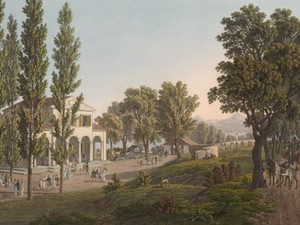
Once the border with the Kingdom of Savoy has been crossed, the traveler finds himself in an area that is very different from the Swiss Confederation - at least if you believe the accompanying text:
"After leaving Cologny, the path moves away from the lakeshore and leads for seven lieues through poorly cultivated land, the small town of Thonon, the former capital of Chablais, and dreary villages where everything tells of the poverty of the inhabitants."
However, relief for the tourist tired by the monotonous route is already in sight: the elegant pavilion of the Baths of Amphion. Before neighboring Evian became a major spa town in 1823, Amphion was known for its iron-rich mineral springs. According to the accompanying text, the three reasons for the town's popularity are: its pleasant location, the beauty of its surroundings and the good company that gathers there.
Voyage pittoresque de Genève à Milan par le Simplon,Paris 1811, Les Eaux d'Amphion, près d'Evian; Germain Hausmann, "Evian", in: Historisches Lexikon der Schweiz (HLS), version of 22.11.2004, translated from the French [17.06.2024]
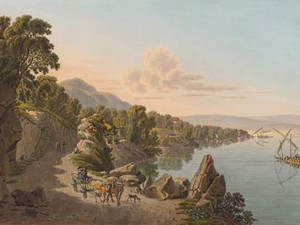
Saint-Gingolph lies on the shores of Lake Geneva opposite Vevey on the border between France and Valais. The village has always been divided in two. At the time this view was created, half of it belonged to the Kingdom of Sardinia-Piedmont and half to the Canton of Vaud. The border between France and Switzerland is formed by the River Morge, which flows through the canton of Vaud and empties into Lake Geneva.
Johann Gottfried Ebel, Anleitung, auf die nützlichste und genussvollste Art die Schweiz zu bereisen, vol. 2, Zurich 1810, p. 75
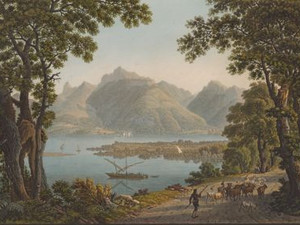
Tourists around 1811 were mainly familiar with the eastern end of Lake Geneva from Jean-Jacques Rousseau's epistolary novel Julie ou la nouvelle Héloïse. This had already been published in 1761 and went through at least 70 editions by 1800 - a veritable bestseller of the 18th century. The tragic love story between the patrician's daughter Julie and her tutor Saint-Preux served Rousseau above all to explain his social, economic and cultural concerns. It is regarded as the forerunner and starting point of Romanticism. Framed romantically by gnarled trees, Gabriel Lory (père?) presents us with a view of the delta of the Rhone estuary and the Dent de Jaman.

Voyage pittoresque de Genève à Milan par le Simplon, Paris 1811, Vue de l'extrémité du lac de Genève, et de l'entrée du Rhône, près le Boveret; Page "Julie oder Die neue Heloise". In: Wikipedia - The free encyclopedia. Edit status: November 8, 2023, 15:20 UTC [06/17/2024]
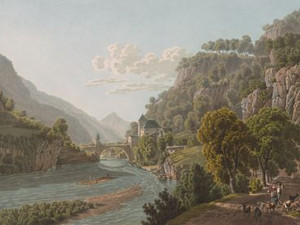
St-Maurice Castle was built at the end of the 15th century and was completely destroyed by fire at the end of the 17th century. Located at the entrance to the Rhône Valley, the castle served as the seat of a governor, as a guard and customs station and, between the 18th and 19th centuries, as an orphanage and old people's home.

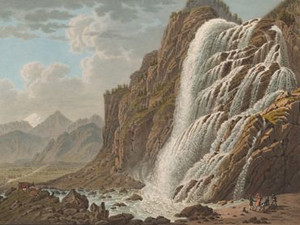
The Pissevache is located on the road between Saint-Maurice and Martigny and impressed many travelers in the 19th century. It is formed by the Salenche torrent and carried plenty of water at the time. Robert Glutz von Blotzheim recommends visiting the waterfall in the morning, as the sun's rays draw a rainbow. Since 1953, some of the water above the Pissevache has been diverted to produce electricity. It now looks much less imposing due to this.
Robert Glutz von Blotzheim, Handbuch für Reisende in der Schweiz, Zurich 1819, p. 287; Voyage pittoresque de Genève à Milan par le Simplon, Paris 1811, Vue de la Cascade de Pissevache; https://www.alpiq.com/de/energieerzeugung/wasserkraftwerke/speicherkraftwerke/salanfe [03.11.2023]

The first view of Sion was drawn from Mont d'Orge. The accompanying text is not very flattering for the people of Valais: the author literally writes that "the appearance of the villages you pass through proves that the accusations of laziness and poor cleanliness made against the Valaisans are all too well-founded". Sion, on the other hand, is one of the most remarkable places in Switzerland due to its white houses, the two castles and the glaciers that surround it.

Voyage pittoresque de Genève à Milan par le Simplon, Paris 1811, Vue de Sion prise du côté du couchant
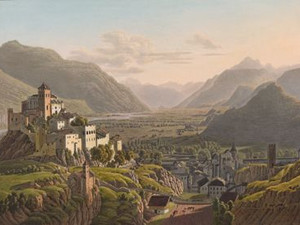
Click on "Open image details" for more information.

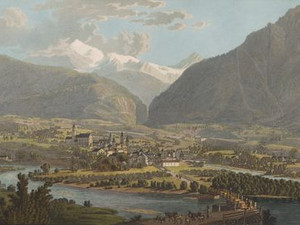
At first glance, Gabriel Lory fils presents us with a classic view of the town at the start of the mountain route over the Simplon. In contrast to earlier depictions of Brig, however, the Alpine crossing over the Simplon comes into focus here. The evenly ascending new pass road was begun in 1801 on the orders of Emperor Napoleon (1769 - 1821) and completed in 1805. It runs through the entire picture and can be seen in the wooded slopes in the middle ground.
In the center of the view is the town of Brig with the Jesuit church and the towers of the Stockalper Palace, which bear witness to an earlier heyday of pass traffic. In the 17th century, Kaspar Stockalper (1609 - 1691) had already had the pass road widened once, after it had previously hardly been used. Control of the pass increased his wealth and earned him the unofficial title of "le roi du Simplon" at the French royal court.
Stockalper's removal from power in 1679 led to a renewed collapse of the infrastructure. The Simplon only regained international importance with the expansion ordered by Napoleon.


Eight bridges and seven tunnels as well as numerous dams and retaining walls overcome the natural obstacles.
The French writer and archaeologist Désiré Raoul-Rochette (1789 - 1854) wrote in 1820: "The Simplon crossing has nothing to compare with it in the work of man. Over a space of fourteen lieues, from Brig to Domo-d'Ossola, it is a kind of battlefield on which nature and art constantly struggle with each other [...]."
The engineer in charge, Nicolas Céard (1745 - 1821), had planned a uniform gradient of 3 - 8 % along the entire route and a road width of 5 - 8 meters. For this reason, the road could not follow the medieval path like Stockalper's road, but had to run along the valley slopes, over streams, through rocky outcrops and the terrifying Gondo Gorge.

Désiré Raoul-Rochette, Lettres sur la Suisse, Paris 1822, p. 375; Federal Inventory of Historic Transport Routes in Switzerland (IVS), VS 1.4.3 (PDF) [03.11.2023]
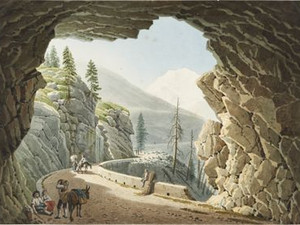
On the western slope of the Mäderhorn towards the Taferna Valley, the road passed through the Schallbett Tunnel, which was around 31 m long.
The national road built from 1960 onwards largely follows the course of the road from 1805, which underlines the extraordinary achievement of Napoleon's engineers and road builders. However, almost nothing of the old road remains. The Schallbett Gallery also fell victim to the modern highway.

Click on "Open image details" for more information.
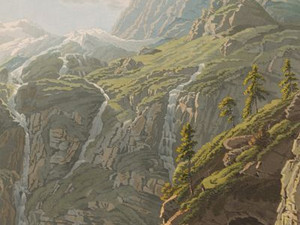
The glacier gallery with the section of road shown in the foreground is the only part of the Napoleon road on the north side of the Simplon still preserved in its 19th century condition.
Nicolas Céard originally wanted to tunnel the entire course of the road in this exposed and difficult terrain below the Chaltwasser glacier. However, Napoleon did not agree to this gigantic project.

A little below the top of the pass in the direction of Italy, Napoleon had a generously dimensioned hospice built in the style of the Great St. Bernard. Construction began in 1813, but was not completed until 1831 by the canton of Valais, as the fall of Napoleon interrupted building work. However, the building site, which had already been prepared in 1808, can be seen.

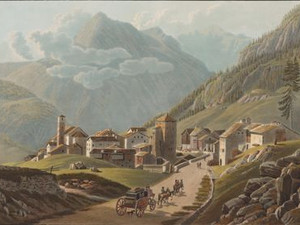
The village of Simplon has always been directly dependent on the pass road and the traffic it brought. After the Simplon railroad tunnel was opened in 1906, the community felt so cut off from the rest of Switzerland that it stayed away from a federal vote in 1907 in protest.

Federal Inventory of Historic Transport Routes in Switzerland (IVS), VS 1 (PDF) [03.11.2023]
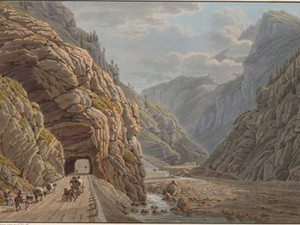
The most challenging section of the Simplon road led through the Gondo Gorge. The gorge was terrifying for the engineers and construction workers as well as for the travelers. However, the latter also seem to have derived a certain thrill from their trip. Désiré Raoul-Rochette (1789 - 1845) wrote about the route: "It is beyond the village of Simplon that the magnificent horrors of this astonishing road unfold in all their extent[...]."
At the upper entrance to the gorge, shortly after the village of Gabi, the road led through the tunnel of the same name, about 65 m long. This was widened during the construction of the N9 in the 1960s to such an extent that nothing remains of it today.
Désiré Raoul-Rochette, Lettres sur la Suisse, Paris 1822, p. 384; Voyage pittoresque de Genève à Milan par le Simplon, Paris 1811, Vue de la Galerie d'Algaby, prise du côté du Valais; Federal Inventory of Historic Transport Routes in Switzerland (IVS), VS 1.4.7 (PDF) [03.11.2023]
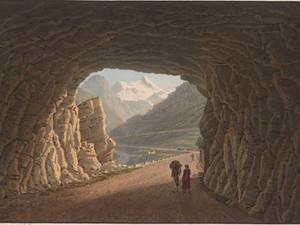
Click on "Open image details" for more information.
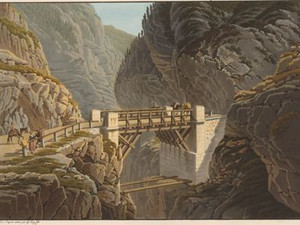
The first of two bridges over the Doveria is the Ponte Alto. Its original wooden roadway can still be seen here, which was replaced by a stone arch between 1850 and 1880.
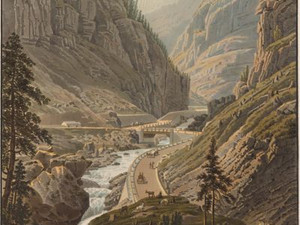
The second crossing of the Doveria takes place via the Casermetta bridge. This view of the route, which stretches evenly along the bottom of the wild gorge, illustrates particularly well what Raoul-Rochette wrote about the Simplon road:
"What is most astonishing about it is that it runs evenly and steadfastly, never yielding to the difficulties it encounters, and concealing under this boldness itself an extreme audacity. Elsewhere I have seen paths hewn out of the rock or suspended over precipices [...]. But here it is a safe and comfortable path of constant width and gradient, continuing its majestic course over all obstacles [...]."
Désire Raoul-Rochette, Lettres sur la Suisse, Paris 1822, p. 375 - 376
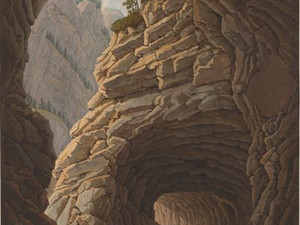
At around 222 m, the Great Tunnel is certainly the most impressive achievement of the miners and engineers. Two large openings were cut out for lighting. The tunnel was driven through the rock within 18 months, during which 200 workers toiled day and night, excavating the rock from four sides simultaneously.
Jean-Pierre Haldi, Bau und Benutzung der Simplonstrasse bis 1820, in: Voyage pittoresque de Genève à Milan 1800-1820,(exhib. cat. Swiss PTT Museum 1994), p. 16; Voyage pittoresque de Genève à Milan par le Simplon, Paris 1811, Vue de l'intérieur de la Grande Galerie
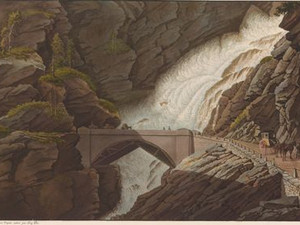
The exit from the Great Gallery leads directly into the valley of the Alpjerbach stream. Its thundering masses of water are crossed by another bridge. As one of the few bridges on the Simplon road, it was built with a stone arch from the very beginning - albeit against the instructions of the chief engineer Nicolas Céard.
Federal Inventory of Historic Transport Routes in Switzerland (I Handbuch für Reisende in der SchweizS), VS 1.4.7 (PDF) [03.11.2023]
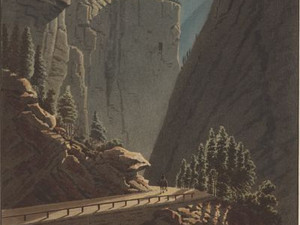
Of all the views in this Voyage pittoresque, this one is most likely to appeal to the public's taste: the lonely traveler in the wilds of nature, on a full moon night no less, is probably the epitome of the romantic attitude to life.
So we leave the territory of the Swiss Confederation at the same time. The next view will already be in the Kingdom of Sardinia-Piedmont.
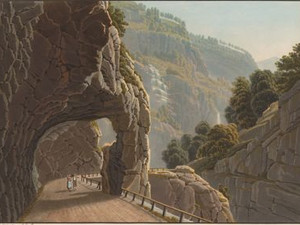
The Italian customs station was located in Iselle. The accompanying text emphasizes the gentler landscape compared to the Gondo Gorge, where the fir trees have been replaced by walnut and chestnut trees. The gallery - one of the more inconspicuous on the Simplon route - rests on a single rock pillar on the river side. A waterfall appears in the center of the picture.
Voyage pittoresque de Genève à Milan par le Simplon, Paris 1811, Vue de la Galerie d'Issel
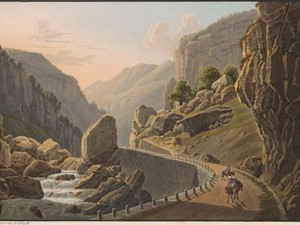
The Val Divedro is the last alpine spectacle in this sequence of views. Thinking they are already in the south, travelers experience the mighty power of mountain nature here once again.
Voyage pittoresque de Genève à Milan par le Simplon, Paris 1811, Entrée du Vallon de Dovedro
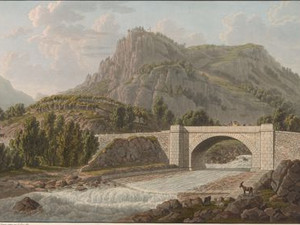
Midway between Gondo and Crevoladossola, the Simplon road crosses the Cairasca stream. The accompanying text now points out the noticeably more southerly character of the landscape, where the climate even permits viticulture.
Voyage pittoresque de Genève à Milan par le Simplon, Paris 1811, Pont sur la Cherasca
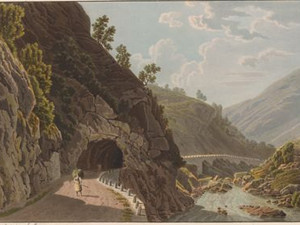
In the lower section, the Val Divedro narrows again so much that a final tunnel with a length of 56 m became necessary.
Voyage pittoresque de Genève à Milan par le Simplon, Paris 1811, Vue de l'entrée de la dernière Galerie dessinée du côté du Simplon
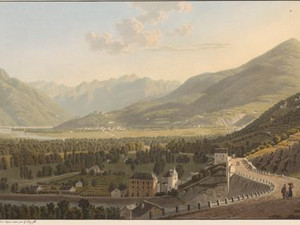
In stark contrast to the landscape behind, the plain of the Val d'Ossola now stretches out before the traveler. In 1809, the journey from Domodossola over the Simplon to Brig took between 14 and 15 hours. Today, it only takes an hour by car from Domodossola to Brig.
Johann Gottfried Ebel, Anleitung auf die nützlichste und genussvollste Art die Schweitz zu bereisen, Zurich 1809, vol. 2, p. 466; Voyage pittoresque de Genève à Milan par le Simplon, Paris 1811, Vue du Pont de Crevola et de la vallée de Domodossola
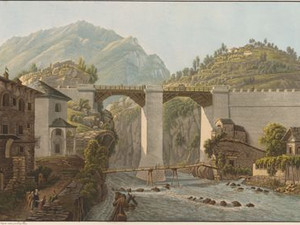
Crevola is the union of two major high Alpine crossings, the Simplon and Gries crossings. The Griesübergang was hardly ever used by travelers, but it was used by muleteers on their way to Valais.
Both Ebel and the commentator of the Voyage pittoresque describe this bridge as an architectural masterpiece. Pillars over 30 m high support the approximately 45 m long wooden roadway over the river, which is called Diveria here.
Voyage pittoresque de Genève à Milan par le Simplon, 1811, Vue du Pont de Crevola; Johann Gottfried Ebel, Anleitung auf die nützlichste und genussvollste Art die Schweitz zu bereisen, Zurich 1810, p. 260

"These hills and mountains no longer have the barren appearance of Switzerland and Valais; their contours are gentle and the rocks are almost everywhere replaced by fresh, smiling greenery. This place [...] conveys an idea of the difference in the picturesque character of the countries on this side and the other side of the Alps."
Villadossola must have provided Gabriel Lory fils with the only "picturesque" view in the entire Valle d'Ossola. The accompanying text informs us that the rest of the valley no longer offers any points of interest for painting enthusiasts. The well-built plain dominates, the mountains are all pyramid-shaped and of little artistic value.
Voyage pittoresque de Genève à Milan par le Simplon, 1811, Villa
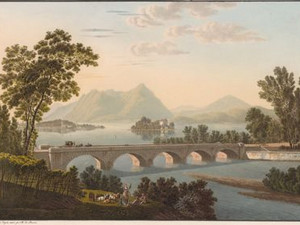
With this view we arrive at Lake Maggiore, about which Ebel writes: "The natural character of this lake is high Alpine wildness combined with the mildness and beauty of the Italian soil and climate, narrow enclosure with wide expanses and distant views."
The road crosses the Selvaspessa here on a five-arched bridge made of white granite with red veins.
Johann Gottfried Ebel, Anleitung auf die nützlichste und genussvollste Art die Schweitz zu bereisen, vol. 3, Zurich 1810, p. 259; Voyage pittoresque de Genève à Milan par le Simplon, 1811, Vue du Pont de Baveno et de l'Isola Madre
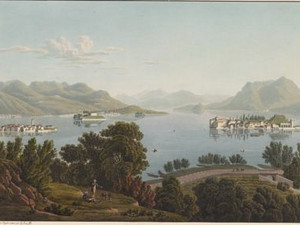
Lake Maggiore lies between Switzerland and Italy and was used to transport goods from Germany and Switzerland to Italy. The ships sailed up the Toccia and down the Ticino, from where a canal led to Milan, where they transported the region's products, such as coal, wood, hay, white marble from Mergozzo and pink granite from Baveno. In addition to this practical function of transporting goods, Lake Maggiore and its islands were also an important place of inspiration for various writers such as Goethe, Hemingway and Stendhal. The latter liked to repeat: "If you have a heart and a shirt, sell the shirt and look at the shores of Lake Maggiore".
Voyage pittoresque de Genève à Milan par le Simplon, Paris 1811, Vue du Lac Majeur et des Iles Borromées; https://www.isoleborromee.it/fr/story/la-storia-visita-palazzo-borromeo/ [26.03.2023]

In 1630, the island was still a rock. The Palazzo Borromeo, which can be seen on this aquatint, was commissioned by Count Borromeo as early as 1632. Napoleon stayed in this palace with his wife Josephine de Beauharnais in 1797. There is still a room named after Napoleon in the palace today. Other famous personalities have stayed at Palazzo Borromeo, such as Johann Wolfgang von Goethe, Stendhal, Ernest Hemingway, Richard Wagner, Queen Victoria and even Prince Charles and Lady Diana.

Voyage pittoresque de Genève à Milan par le Simplon, Paris 1811, Vue de l'Isola Bella; https://www.isoleborromee.it/fr/story/la-storia-visita-palazzo-borromeo/ [26.03.2023]

From Stresa, people were ferried to the Borromean Islands, as evidenced by the boat landing stage.

Johann Gottfried Ebel, Anleitung auf die nützlichste und genussvollste Art die Schweitz zu bereisen, vol. 4, Zurich 1810, p. 243

Click on "Open image details" for more information.


In the summer of 1809, when Gabriel Lory fils and Maximilien de Meuron were staying on Lake Maggiore, there was still no bridge over the Ticino at Sesto Calende. Instead, a ferry connected the two sections of road coming from the Simplon and leading to Milan.
Here, at the southern end of the lake, the view back to the north reminds us of the journey: we have crossed the Alpine chain with the Monte Rosa massif at its center to now linger in the sunny south.
Marie-Louise Schaller, Voyage pittoresque de Genève à Milan, in: Voyage pittoresque de Genève à Milan 1800-1820, (exhib. cat. Swiss PTT Museum 1994), pp. 37-68, Voyage pittoresque de Genève à Milan par le Simplon, Paris 1811, Vue de Sesto
Marie-Louise Schaller, Voyage pittoresque de Genève à Milan,in: Voyage pittoresque de Genève à Milan 1800-1820,(exhib. cat. Swiss PTT Museum 1994), pp. 37-68